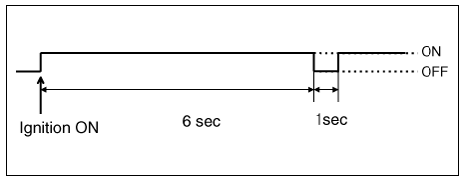KIA Niro: Restraint / Description And Operation
Warning Lamp Activation
Warning Lamp Behavior after Ignition On
As soon as the operating voltage is applied to the SRSCM ignition input, the SRSCM activates the warning lamp for a LED lamp check.
The lamp shall turn on for 6 seconds during the initialization phase and be turned off afterward.
To alert the driver, the warning lamp shall turn on for 6 seconds and off for one second then on continuously after the operating voltage is applied if any active fault exists.
- Active fault or historical fault counter is greater or equal to 10.

- Normal or historical fault counter is less than 10.

- When turning the ignition switch ON during variant coding (EOL) mode,
the airbag warning lamp
illuminates and blinks at intervals of 1 second till the coding is
completed.
In case the variant coding is completed normally, the airbag warning lamp is turned on for 6 seconds, and then turned off. Otherwise the airbag warning lamp continuously blinks at intervals of 1 second.
(1) In case the variant coding is completed normally.

(2) In case the variant coding is not completed.

When there is active fault in airbag system or SRSCM internal fault, the variant coding (EOL) can't be completed. In this case, do the variant coding (EOL) procedure again after troubleshooting with the KDS/GDS.
SRSCM Independent Warning Lamp Activation
There are certain fault conditions in which the SRSCM cannot function and thus cannot control the operation of the standard warning lamp. In these cases, the standard warning lamp is directly activated by appropriate circuitry that operates independently of the SRSCM. These cases are:
- Loss of battery supply to the SRSCM : warning lamp turned on continuously.
- Loss of internal operating voltage : warning lamp turned on continuously.
- Loss of Microprocessor operation : warning lamp turned on continuously.
- SRSCM not connected : warning lamp turned on continuously.
Telltale Lamp Activation
The Telltale Lamp indicates the Passenger Airbag(PAB) enabled and disabled status based on occupant status of passenger seat. If the passenger seat is empty or occupied with a child (or child seat), the Passenger Airbag is disabled and the Telltale Lamp is turned ON to inform the driver that the PAB is disabled. As soon as operating voltage is applied to the SRSCM ignition input, the SRSCM activates telltale lamp prove out. ODS (Occupant Detection System) will send an indeterminate status to the SRSCM as a default setting for passenger airbag deployment during the prove out period.
After ignition on, telltale lamp will turn on for 4 seconds and turn off for 3 seconds during the initialization phase and be turned ON afterward until receipt of valid enabled message from ODS system.

Restraint / Repair Procedures
Component Replacement After Deployment
Warning
Before doing any SRS repairs, use the KDS/GDS to check for DTCs. Refer to the Diagnostic Trouble Code list for repairing of the related DTCs.
When the front airbag(s) deployed after a collision, replace the following items.
- SRSCM
- Deployed airbag(s)
- Seat belt pretensioner(s)
- Front impact sensors
- Inspect the clock spring for heat damage.
If any damage found, replace the clock spring.
When the side/curtain airbag(s) deployed after a collision, replace the following items.
- SRSCM
- Deployed airbag(s)
- Side impact sensor(s) for the deployed side(s)
After the vehicle is completely repaired, confirm the SRS airbag system is OK.
- Turn the ignition switch ON; the SRS indicator should come on for about six seconds and then go off.
READ NEXT:
 Driver Airbag (DAB) Module and Clock Spring
Driver Airbag (DAB) Module and Clock Spring
Driver Airbag (DAB) Module and Clock Spring Description and operation
Description
Driver Airbag (DAB) is installed in the steering wheel and electrically
connected to SRSCM via the
clock spring.
It protects the driver by deploying the airbag
 Passenger Airbag (PAB) and Side Airbag (SAB)
Passenger Airbag (PAB) and Side Airbag (SAB)
Passenger Airbag (PAB) Module Description and operation
Description
The passenger airbag (PAB) is installed inside the crash pad and protects the front passenger in the event of a frontal crash. The SRSCM determines if and when to deploy the PAB.
SEE MORE:
 Water pump Repair procedures
Water pump Repair procedures
Removal
Warning
Be sure to read and follow the "General Safety Information and
Caution" before doing any work related
with the high voltage system. Failure to follow the safety instructions may
result in serious electrical
injuries.
 Troubleshooting - Tire Pressure Monitoring System
Troubleshooting - Tire Pressure Monitoring System
TPMS Inspection method
Inspection
Warning
Find the inspection number by referring to the table above.
The following content is irrelevant of the inspection procedure.
Warning lamp types
Stays on without blinking : Low pressure tir
Categories
- Home
- KIA Niro EV, Hybrid - Second generation - (SG2) (2021-2024) - Owner's manual
- Kia Niro - First generation - (DE) (2017-2022) - Service and Repair Manual
- Contact Us
